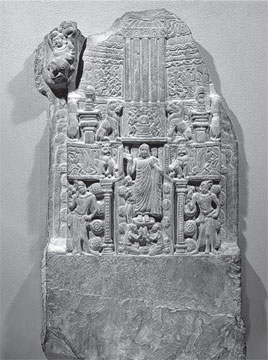|
Andhra Pradesh:
The cradle of Buddhist civilisation
by Nagalingam KUMARAKURUPARAN
In the Indian subcontinent no other region is so rich in ancient
Buddhist monuments as Andhra Pradesh is.
For about thousand years (300 BC to 600 AD) Buddhism exerted profound
influence on the socio-cultural life of the Andhras especially during
the Satavahana period when the rich artisan and trading communities
patronised it and raised magnificent monuments in its honour.
 |
|
Buddha's descent from
the Trayastrinsha heaven |
In South India, Andhra Pradesh occupies a place of pride in the
history of Buddhism - especially in its philosophy and Art. Andhras were
the earliest ones who extended enthusiastic welcome to Buddhism, and
both the Theravada and the Mahayana systems enjoyed their liberal
patronage.
Discoveries
The recent discoveries have revealed that, though in a humble way,
the building activity by the local Buddhists goes back to pre-Asokan
times, it reached its zenith during the later Satavahana and Iksvaku
periods (100 BC to 300 AD).
The excavated sites have brought out the grandeur and magnificence of
stupas and viharas both rock-cut and brick built and captivating beauty
of sculptures that once adorned them.
The discoveries throw ample light on the history of Buddhism in
Andhra Pradesh.During British rule James Burgess did a monumental work
on the Buddhist stupas of Amaravati. Alexander Rea, who excavated
several sites produced a nearly comprehensive work entitled South Indian
Buddhist Antiquities. Several scholars have worked on the Andhra
Buddhist monuments, and have published works on its different aspects.
Amaravati
The recent finds in the excavations at Amaravati have pushed back the
antiquity of Buddhism in Andhra Pradesh to the pre-Asokan period.
Emperor Asoka is said to have erected pillars at places which already
had Buddhist Associations and a fragment of pillar with a few lines of
Asoka's edict is found at Amaravati.The pillar edict makes it clear that
the place had already Buddhist Associations.
The evidence is further confirmed by the recent excavations.
It may be added that from the beginning, the Andhras had been in the
forefront of all movements which sought to popularise the doctrine of
Buddha.
Andhra Pradesh was hospitable to both Mahayana and Theravada
Buddhism. There existed intimate cultural relations between Andhra
Pradesh and Sri Lanka since the time of Asoka and several Sri Lankan
Theravada fraternities had their viharas in the Nagarjunakonda
valley.One of the Nagarjunakonda inscriptions mentions 'Sihala Vihara'
on Chuladhammagiri.
"One of the Sri Lankan kings of the third century AD made permanent
gifts to 'Sihala Vihara' and built a dining hall for Sri Lankan Bhikkhus
at "Nagarjunakonda," (Nagarjuna Hill).
Saivites
Buddhists in Andhra Pradesh preferred hilltops for their
establishments and they are generally faraway from the disturbing areas
of towns and villages.
Later Saivites and Vaisnavites followed the tradition and chose to
have their Holy places on hills - Sri Sailam and Tirumala Tirupati
attracting people from different parts of the land. Amaravati was
another important Buddhist centre in Andhra Pradesh.
The stupa at Amaravati is famous all over the world.
The ancient name of Amaravati known from inscriptions and literature
is Dhanyakataka. It might have been one of the 30 walled towns in Andhra
Pradesh during Satavahana period mentioned by Megasthanes.
The origin and development of the 'Mahacaitya' at Amaravati extends
over a thousand years (300 BC to 700 AD). During the period the stupa
was renovated and enlarged several times and fully decorated from time
to time.
Asoka
Having its origins during pre-Asokan times, the Amaravati stupa was
rebuilt by Emperor Asoka and received rich additions during the
Satavahana, Iksvaku and Pallava periods to become the most magnificent
of the Buddhist monuments in the contemporary world.
Buddhaghosha
Amaravati and Nagarjunakonda also became centres of higher learning
of international reputation. Buddhaghosa of Kanchipuram who had restored
the Pali canon to India from Sri Lanka and the author of Visuddhi Magga
an encyclopaedic work on Theravada Buddhism might have spent his last
days in Sihala Vihara at Nagarjunakonda.
The Chinese pilgrim Hiuen Tsang wrote that he had studied Abhidhamma
at Amaravati Achrya Nagarjuna who had illuminated the Buddhist world
with his intellectual eminence, and considered as one of the greatest
philosophers, the world has ever produced, taught at Amaravati.
Devout Buddhists of China, Japan, Tibet and other Far Eastern
countries consider him to be a great Buddhist teacher who again set in
motion the wheel of Dhamma.
Nagarjuna a magical name that baffles the most brainy in sheer
intellectual power and moral force.
The Buddha's doctrine was responsible for uniting the Andhras into a
single race and in return the Andhras played a remarkable role not only
in its geographical extension, but also in developing and enriching the
Buddhist philosophy and religion.
Buddhism had been a strong force in the social and cultural history
of Andhra Pradesh for about thousand years.
Such was the impact of Buddhism in Andhra Pradesh. Later in the
period of Bhakti Movement (Devotional period) in the 7th century AD
Gautama Buddha was placed by the Hindus among the pantheon of Avatars as
the incarnation of God Maha Vishnu.
|


